Mapping Irrigated Areas of Northeast China in Comparison to Natural Vegetation
Abstract
1. Introduction
2. Study Area
3. Data and Methods
3.1. Methodology
- Step (1) The mean NDVI (NDVIC) and LSWI (LSWIC) values were calculated for each cropland pixel during the peak of the growing season, from the 201st to the 241st day.
- Step (2) The nearest 30 forest pixels for each cropland pixel were selected by comparing NDVIC and mean NDVI values of forest (NDVIF) as described above.
- Step (3) The LSWI difference (LSWIDIff) between the cropland pixel (LSWIC) and the adjacent forest pixels (LSWIF) was calculated for each cropland pixel.
- Step (4) Based on the relationship between LSWIDiff0 and MAP at the prefectures as described above, LSWIDiff0 was calculated at all prefectures using MAP.
- Step (5) At each prefecture, all pixels were sorted by descending LSWIDiff, and the pixels with LSWIDiff >LSWIDiff0 were identified as irrigation pixels.
3.2. MODIS Data and Precipitation Data Preprocessing
3.3. Method Validation
4. Results
5. Discussion
6. Conclusions
Author Contributions
Funding
Acknowledgments
Conflicts of Interest
References
- Bruinsma, J. (Ed.) World Agriculture: Towards 2015/2030. An FAO Perspective; FAO and Earthscan Publ.: Rome, Italy; London, UK, 2003. [Google Scholar]
- Portmann, F.T.; Siebert, S.; Döll, P. MIRCA2000-Global monthly irrigated and rainfed crop areas around the year 2000: A new high-resolution data set for agricultural and hydrological modeling. Glob. Biogeochem. Cycles 2010, 24. [Google Scholar] [CrossRef]
- Yuan, W.; Liu, D.; Dong, W.; Liu, S.; Zhou, G.; Yu, G. Multiyear precipitation reduction strongly decreases carbon uptake over northern China. J. Geophys. Res. Biogeosciences 2014, 119, 881–896. [Google Scholar] [CrossRef]
- Ma, J.; Hoekstra, A.Y.; Wang, H.; Chapagain, A.K.; Wang, D. Virtual versus real water transfers within China. Philos. Trans. R. Soc. B 2006, 361, 835–842. [Google Scholar] [CrossRef]
- Veneman, A.M.; Jen, J.J.; Bosecker, R. Census of Agriculture-Farm and Ranch Irrigation Survey (2003), United States Department of Agriculture (USDA), National Agricultural Statistics Survey (NASS). Available online: http://www.usda.gov/nass/ (accessed on 4 April 2019).
- Yuan, W.; Liu, S.G.; Liu, W.; Zhao, S.Q.; Dong, W.J.; Tao, F.L.; Chen, M.; Lin, H. Opportunistic Market-Driven Regional Shifts of Cropping Practices Reduce Food Production Capacity of China. Earth’s Future 2018, 6, 634–642. [Google Scholar] [CrossRef]
- Food and Agriculture Organization of the United Nations (FAO): FAO Statistical Databases (FAOSTAT). Available online: http://faostat.fao.org/ (accessed on 4 April 2019).
- United Nations. United Nations Commission on Sustainable Development (UNCSD): Comprehensive Assessment of the Freshwater Resources of the World; Report E/CN.17/1997/9; Stockholm Environment Institute (SEI): Stockholm, Sweden.
- Popova, Z.; Kercheva, M. CERES model application for increasing preparedness to climate variability in agricultural planning—Risk analyses. Phys. Chem. Earth. 2005, 30, 117–124. [Google Scholar] [CrossRef]
- Shiklomanov, I.A. Appraisal and Assessment of World Water Resources. Water Int. 2000, 25, 11–32. [Google Scholar] [CrossRef]
- Ozdogan, M.; Yang, Y.; Allez, G.; Cervantes, C. Remote sensing of irrigated agriculture: Opportunities and challenges. Remote Sens. 2010, 2, 2274–2304. [Google Scholar] [CrossRef]
- Thenkabail, P.S.; Schull, M.; Turral, H. Ganges and Indus river basin land use/land cover (LULC) and irrigated area mapping using continuous streams of MODIS data. Remote Sens. Environ. 2005, 95, 317–341. [Google Scholar] [CrossRef]
- Ozdogan, M.; Gutman, G. A new methodology to map irrigated areas using multi-temporal MODIS and ancillary data: An application example in the continental US. Remote Sens. Environ. 2008, 112, 3520–3537. [Google Scholar] [CrossRef]
- Thenkabail, P.S.; Dheeravath, V.; Biradar, C.M.; Gangalakunta, O.R.P.; Noojipady, P.; Gurappa, C.; Velpuri, M.; Gumma, M.; Li, Y. Irrigated Area Maps and Statistics of India Using Remote Sensing and National Statistics. Remote Sens. 2009, 1, 50–67. [Google Scholar] [CrossRef]
- Dheeravath, V.; Thenkabail, P.S.; Chandrakantha, G.; Noojipady, P.; Reddy, G.P.O.; Biradar, C.M.; Gumma, M.K.; Velpuri, M. Irrigated areas of India derived using MODIS 500 m time series for the years 2001–2003. ISPRS J. Photogramm. Remote Sens. 2010, 65, 42–59. [Google Scholar] [CrossRef]
- Brown, J.F.; Pervez, M.S. Merging remote sensing data and national agricultural statistics to model change in irrigated agriculture. Agric. Syst. 2014, 127, 28–40. [Google Scholar] [CrossRef]
- Abuzar, M.; Mcallister, A.; Whitfield, D. Thresholds Derived from Landsat and ASTER Data in an Irrigation District of Australia. Photogramm. Eng. Remote Sens. 2015, 81, 229–238. [Google Scholar]
- Salmon, J.M.; Friedl, M.A.; Frolking, S.; Wisser, D.; Douglas, E.M. Global rain-fed, irrigated, and paddy croplands: A new high resolution map derived from remote sensing, crop inventories and climate data. Int. J. Appl. Earth Obs. Geoinf. 2015, 38, 321–334. [Google Scholar] [CrossRef]
- Biggs, T.W.; Thenkabail, P.S.; Gumma, M.K.; Scott, C.A.; Parthasaradhi, G.R.; Turral, H.N. Irrigated area mapping in heterogeneous landscapes with MODIS time series, ground truth and census data, Krishna Basin, India. Int. J. Remote Sens. 2006, 27, 4245–4266. [Google Scholar] [CrossRef]
- EL-Magd, I.A.; Tanton, T.W. Improvements in land use mapping for irrigated agriculture from satellite sensor data using a multi-stage maximum likelihood classification. Int. J. Remote Sens. 2003, 24, 4197–4206. [Google Scholar] [CrossRef]
- Simonneaux, V.; Duchemin, B.; Helson, D.; Er-Raki, S.; Olioso, A.; Chehbouni, A.G. The use of high-resolution image time series for crop classification and evapotranspiration estimate over an irrigated area in central Morocco. Int. J. Remote Sens. 2008, 29, 95–116. [Google Scholar] [CrossRef]
- Gumma, M.K.; Thenkabail, P.S.; Hideto, F.; Nelson, A.; Dheeravath, V.; Busia, D.; Rala, A. Mapping Irrigated Areas of Ghana Using Fusion of 30 m and 250 m Resolution Remote-Sensing Data. Remote Sens. 2011, 3, 816–835. [Google Scholar] [CrossRef]
- Löw, F.; Schorcht, G.; Michel, U.; Dech, S.; Conrad, C. Per-field crop classification in irrigated agricultural regions in middle Asia using random forest and support vector machine ensemble. Proc. SPIE 2012, 8538. [Google Scholar] [CrossRef]
- Lebourgeois, V.; Dupuy, S.; Vintrou, E.; Ameline, M.; Butler, S.; Bégué, A. A Combined Random Forest and OBIA Classification Scheme for Mapping Smallholder Agriculture at Different Nomenclature Levels Using Multisource Data (Simulated Sentinel-2 Time Series, VHRS and DEM). Remote Sens. 2017, 9, 259. [Google Scholar] [CrossRef]
- Bégué, A.; Arvor, D.; Bellon, B.; Betbeder, J.; Abelleyra, D.D.; Ferraz, R.P.D. Remote Sensing and Cropping Practices: A Review. Remote Sens. 2018, 10, 99. [Google Scholar] [CrossRef]
- Brown, J.C.; Kastens, J.H.; Coutinho, A.C.; Victoria, D.D.C.; Bishop, C.R. Classifying multiyear agricultural land use data from Mato Grosso using time-series MODIS vegetation index data. Remote Sens. Environ. 2013, 130, 39–50. [Google Scholar] [CrossRef]
- Liu, W.; Dong, J.; Xiang, K.; Wang, S.; Han, W.; Yuan, W. A sub-pixel method for estimating planting fraction of paddy rice in Northeast China. Remote Sens. Environ. 2018, 205, 305–314. [Google Scholar] [CrossRef]
- Kamthonkiat, D.; Honda, K.; Turral, H.; Tripathi, N.; Wuwongse, V. Discrimination of irrigated and rainfed rice in a tropical agricultural system using SPOT VEGETATION NDVI and rainfall data. Int. J. Remote Sens. 2005, 26, 2527–2547. [Google Scholar] [CrossRef]
- Chen, Y.L.; Lu, D.S.; Luo, L.F.; Pokhrel, Y.; Deb, K.; Huang, J.F.; Ran, Y.H. Detecting irrigation extent, frequency, and timing in a heterogeneous arid agricultural region using MODIS time series, Landsat imagery, and ancillary data. Remote Sens. Environ. 2018, 204, 197–211. [Google Scholar] [CrossRef]
- Döll, P.; Siebert, S.A. Digital Global Map of Irrigated Areas. ICID J. 1999, 49, 55–66. [Google Scholar]
- Siebert, S.; Henrich, V.; Frenken, K.; Burke, J. Update of the Digital Global Map of Irrigation Areas to Version 5.0; FAO: Rome, Italy, 2013. [Google Scholar]
- Thenkabail, P.S.; Biradar, C.M.; Noojipady, P.; Dheeravath, V.; Li, Y.; Velpuri, M.; Gumma, M.; Gangalakunta, O.R.P.; Turral, H.; Cai, X. Global irrigated area map (GIAM), derived from remote sensing, for the end of the last millennium. Int. J. Remote Sens. 2009, 30, 3679–3733. [Google Scholar] [CrossRef]
- Arino, O.; Gross, D.; Ranera, F.; Leroy, M.; Bicheron, P.; Brockman, C. GlobCover: ESA service for Global Land Cover from MERIS. In Proceedings of the 2007 IEEE International Geoscience and Remote Sensing Symposium, Barcelona, Spain, 23–28 July 2007. [Google Scholar]
- Zhu, X.; Zhu, W.; Zhang, J.; Pan, Y. Mapping Irrigated Areas in China From Remote Sensing and Statistical Data. IEEE Appl. Earth Obs. Remote Sens. 2015, 7, 4490–4504. [Google Scholar] [CrossRef]
- National Bureau of Statistics of China. China Statistical Yearbook 2017; China Statistics Press: Beijing, China, 2017. [Google Scholar]
- Wu, P.T.; Jin, J.M.; Zhao, X.N. Impact of climate change and irrigation technology advancement on agricultural water use in China. Clim. Change 2010, 100, 797–805. [Google Scholar] [CrossRef]
- Jin, N.; Tao, B.; Ren, W.; Feng, M.; Sun, R.; He, L.; Zhuang, W.; Yu, Q. Mapping Irrigated and Rainfed Wheat Areas Using Multi-Temporal Satellite Data. Remote Sens. 2016, 8, 207. [Google Scholar] [CrossRef]
- Boschetti, M.; Nutini, F.; Manfron, G.; Brivio, P.A.; Nelson, A. Comparative Analysis of Normalised Difference Spectral Indices Derived from MODIS for Detecting Surface Water in Flooded Rice Cropping Systems. PLoS ONE 2014, 9, e88741. [Google Scholar] [CrossRef] [PubMed]
- Chandrasekar, K.; Sesha Sai, M.V.R.; Roy, P.S.; Dwevedi, R.S. Land Surface Water Index (LSWI) response to rainfall and NDVI using the MODIS Vegetation Index product. Int. J. Remote Sens. 2010, 31, 3987–4005. [Google Scholar] [CrossRef]
- Xiao, X.; Boles, S.; Liu, J.; Zhuang, D.; Frolking, S.; Li, C.; Salas, W.; Moore, B. Mapping paddy rice agriculture in southern China using multi-temporal MODIS images. Remote Sens. Environ. 2005, 95, 480–492. [Google Scholar] [CrossRef]
- Chen, J.; Jönsson, P.; Tamura, M.; Gu, Z.; Matsushita, B.; Eklundh, L. A simple method for reconstructing a high-quality NDVI time-series data set based on the Savitzky-Golay filter. Remote Sens. Environ. 2004, 91, 332–344. [Google Scholar] [CrossRef]
- Yuan, W.; Xu, B.; Chen, Z.; Xia, J.; Xu, W.; Chen, Y. Validation of China-wide interpolated daily climate variables from 1960 to 2011. Theor. Appl. Climatol. 2015, 119, 689–700. [Google Scholar] [CrossRef]
- Heilongjiang Stastical Bureau. Heilongjiang Statistical Yearbook in 2016; China Statistics Press: Beijing, China, 2016. [Google Scholar]
- Jilin Statistical Bureau. Jilin Statistical Yearbook in 2016; China Statistics Press: Beijing, China, 2016. [Google Scholar]
- Liaoning Statistical Bureau. Liaoning Statistical Yearbook in 2016; China Statistics Press: Beijing, China, 2016. [Google Scholar]
- Wardlow, B.D.; Egbert, S.L. Large-area crop mapping using time-series MODIS 250 m NDVI data: An assessment for the US Central Great Plains. Remote Sens. Environ. 2008, 112, 1096–111. [Google Scholar] [CrossRef]
- Li, A.; Wang, Q.; Bian, J.; Lei, G. An Improved Physics-Based Model for Topographic Correction of Landsat TM Images. Remote Sens. 2015, 7, 6296–6319. [Google Scholar] [CrossRef]
- Qiu, Y.; Fu, B.; Wang, J.; Chen, L. Soil moisture variation in relation to topography and land use in a hillslope catchment of the Loess Plateau, China. J. Hydrol. 2001, 240, 243–263. [Google Scholar] [CrossRef]
- Wen, Z.; Wu, S.; Chen, J.; Lü, M.Q. NDVI indicated long-term interannual changes in vegetation activities and their responses to climatic and anthropogenic factors in the Three Gorges Reservoir Region, China. Sci. Total Environ. 2017, 574, 947–959. [Google Scholar] [CrossRef]
- Peng, D.; Wu, C.; Li, C.; Zhang, X.; Liu, Z.; Ye, H. Spring green-up phenology products derived from MODIS NDVI and EVI: Intercomparison, interpretation and validation using National Phenology Network and AmeriFlux observations. Ecol. Indic. 2017, 77, 323–336. [Google Scholar] [CrossRef]
- Hopmans, J.W.; Bales, R.C.; O’Geen, A.T.; Meadows, M.; Hartsough, P.C.; Kirchner, P.; Hunsaker, C.T.; Beaudette, D.; Bales, R.C. Soil moisture response to snowmelt and rainfall in a sierra nevada mixed-conifer forest. Vadose Zone J. 2012, 11, 786–799. [Google Scholar] [CrossRef]
- Mcintyre, P.J.; Thorne, J.H.; Dolanc, C.R.; Flint, A.L.; Flint, L.E.; Kelly, M. Twentieth-century shifts in forest structure in California: Denser forests, smaller trees, and increased dominance of oaks. Proc. Natl. Acad. Sci. USA 2015, 112, 1458–1463. [Google Scholar] [CrossRef]
- Szilagyi, J. Can a vegetation index derived from remote sensing be indicative of areal transpiration? Ecol. Model. 2000, 127, 65–79. [Google Scholar] [CrossRef]
- Waring, R.H.; Running, S.W. Forest Ecosystems: Analysis at Multiple Scales; Academic Press: New York, NY, USA, 1998. [Google Scholar]
- Zhong, L.; Gong, P.; Biging, G.S. Efficient corn and soybean mapping with temporal extendability: A multi-year experiment using Landsat imagery. Remote Sens. Environ. 2014, 140, 1–13. [Google Scholar] [CrossRef]
- Dong, J.; Xiao, X.; Kou, W.; Qin, Y.; Zhang, G.; Li, L.; Jin, C.; Zhou, Y.; Wang, J.; Biradar, C. Tracking the dynamics of paddy rice planting area in 1986–2010 through time series Landsat images and phenology-based algorithms. Remote Sens. Environ. 2015, 160, 99–113. [Google Scholar] [CrossRef]
- Zhu, C.; Lu, D.; Victoria, D.; Dutra, L. Mapping Fractional Cropland Distribution in Mato Grosso, Brazil Using Time Series MODIS Enhanced Vegetation Index and Landsat Thematic Mapper Data. Remote Sens. 2015, 8, 22. [Google Scholar] [CrossRef]
- Beltrán, C.M.; Belmonte, A.C. Irrigated crop area estimation using Landsat TM imagery in La Mancha, Spain. ISPRS J. Photogramm. Remote Sens. 2001, 67, 1177–1184. [Google Scholar]
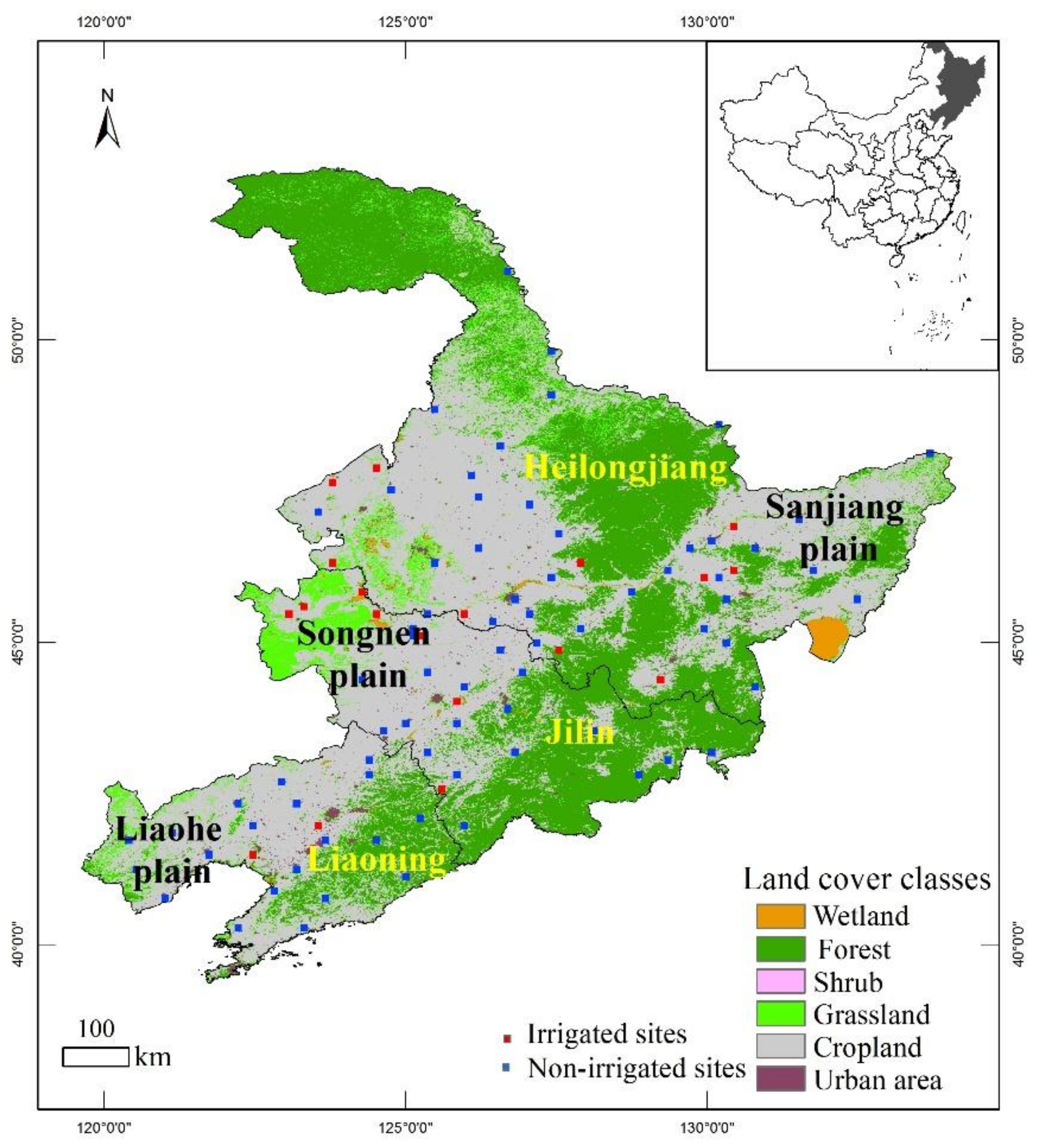

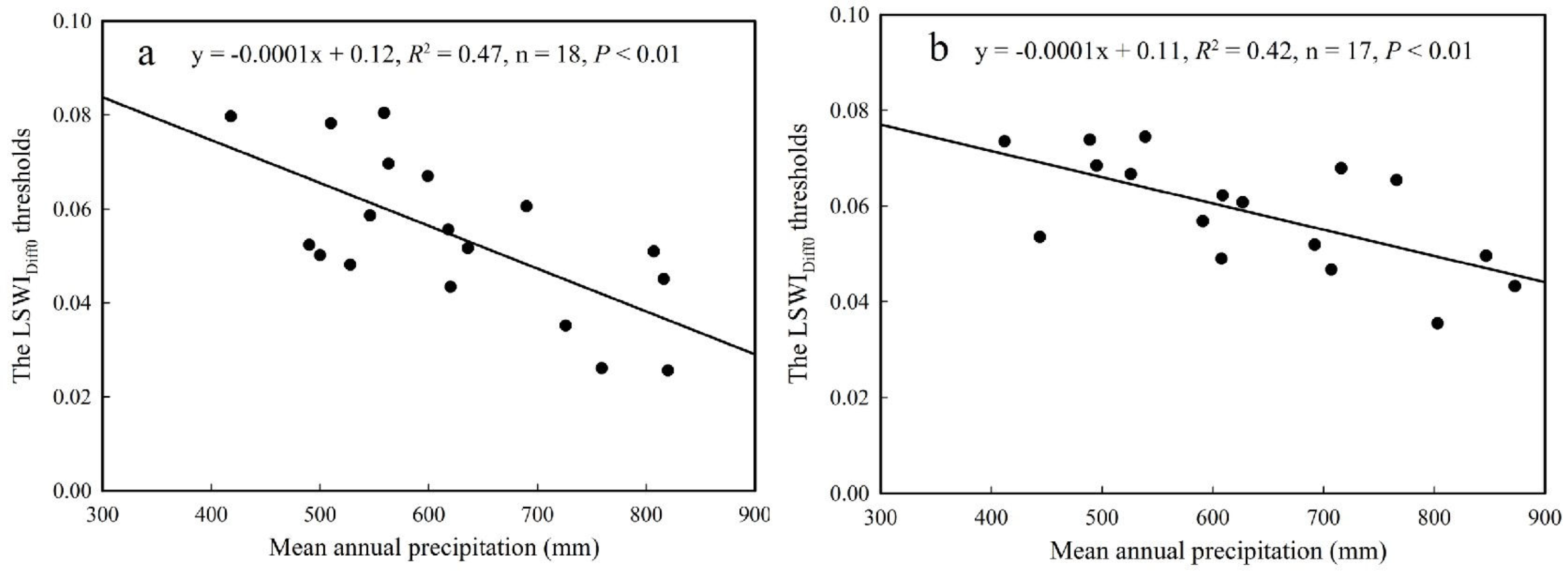
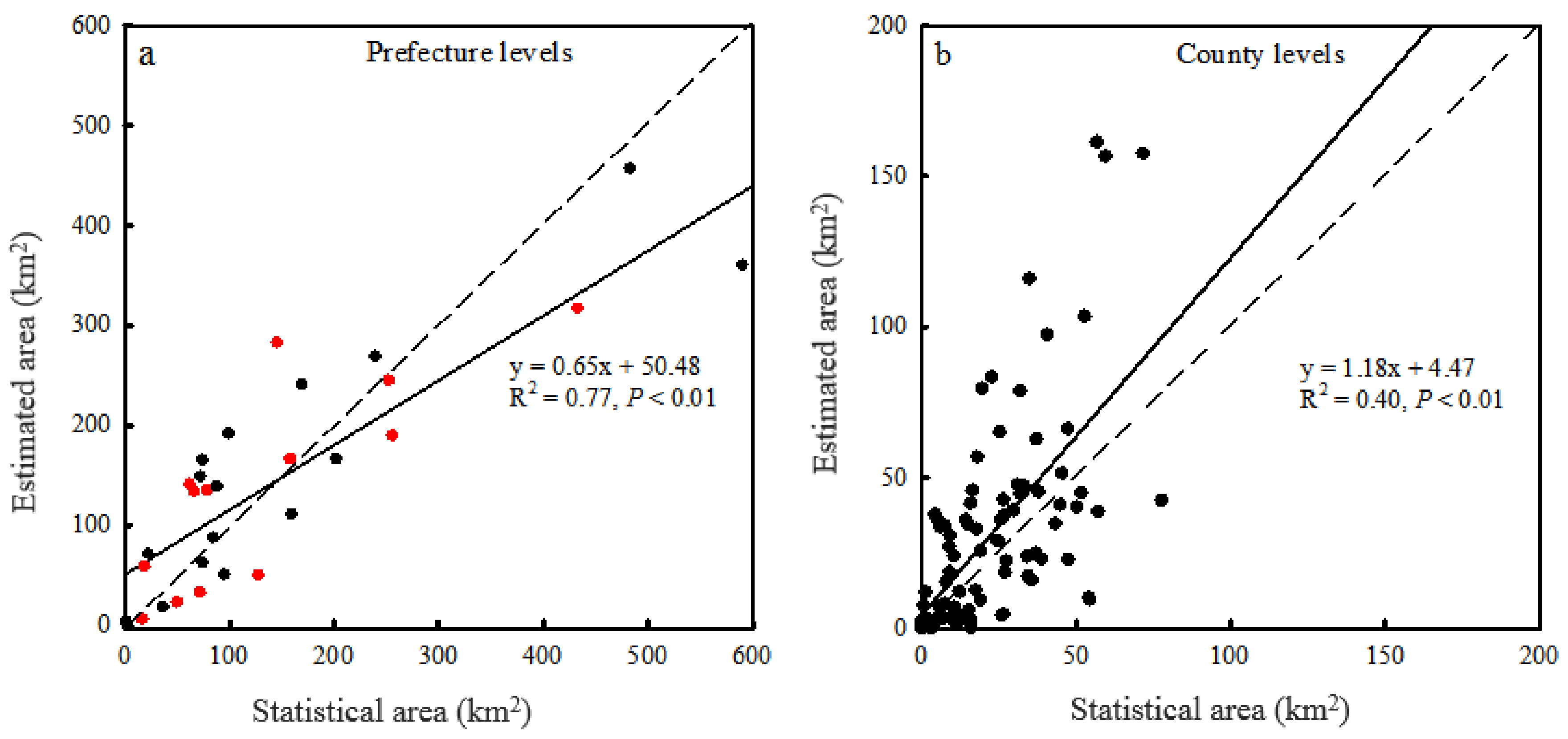
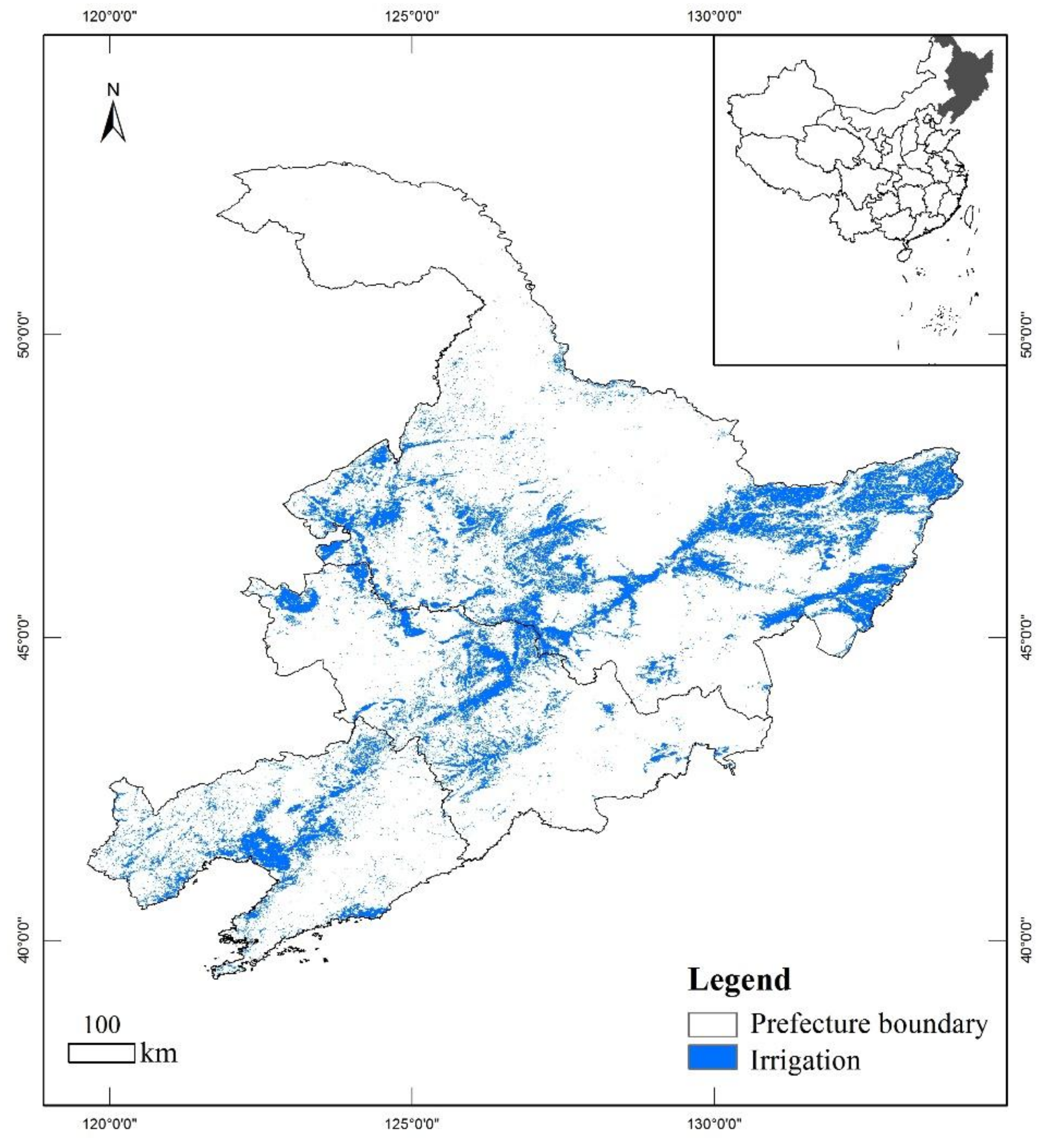
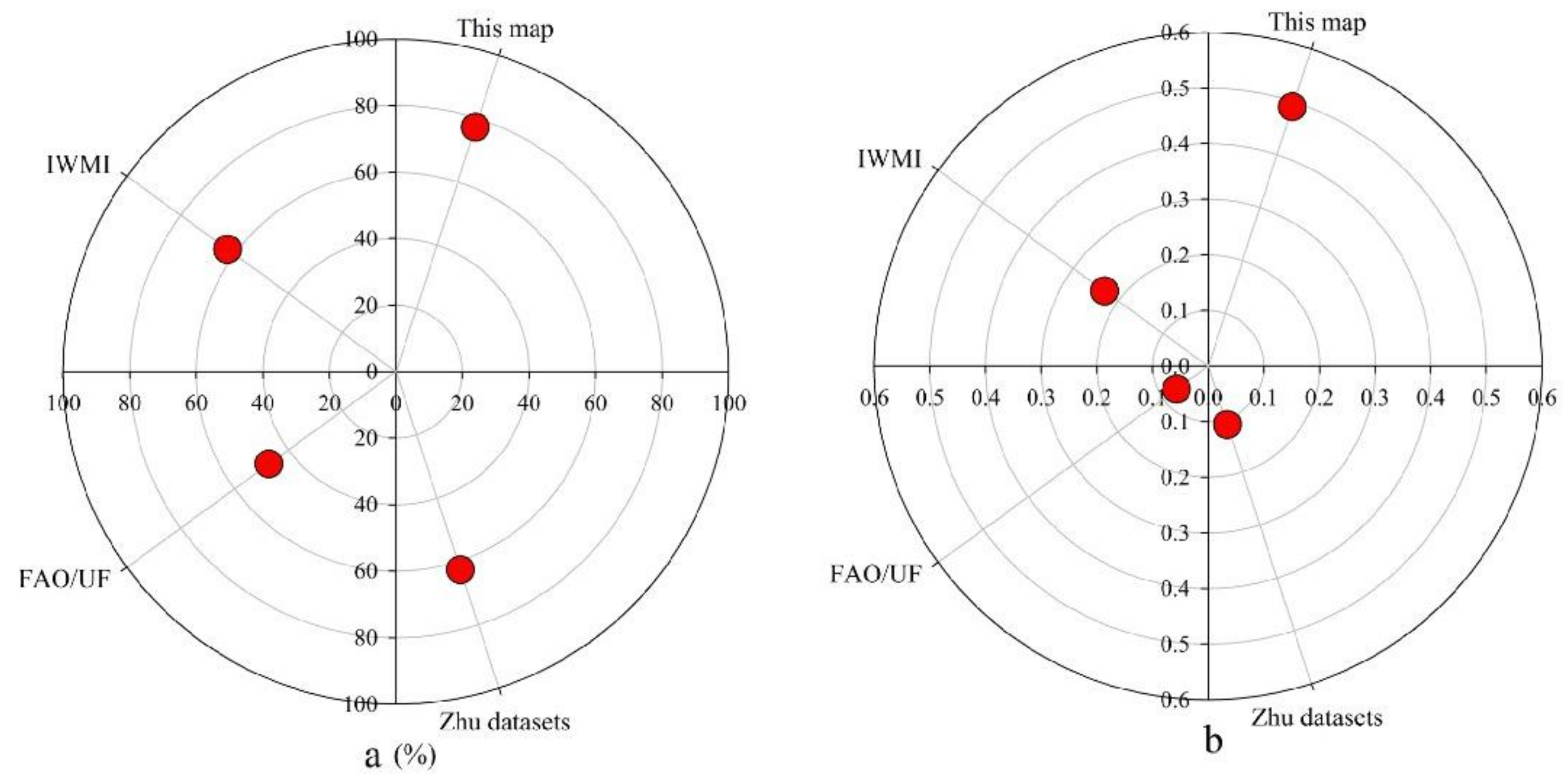
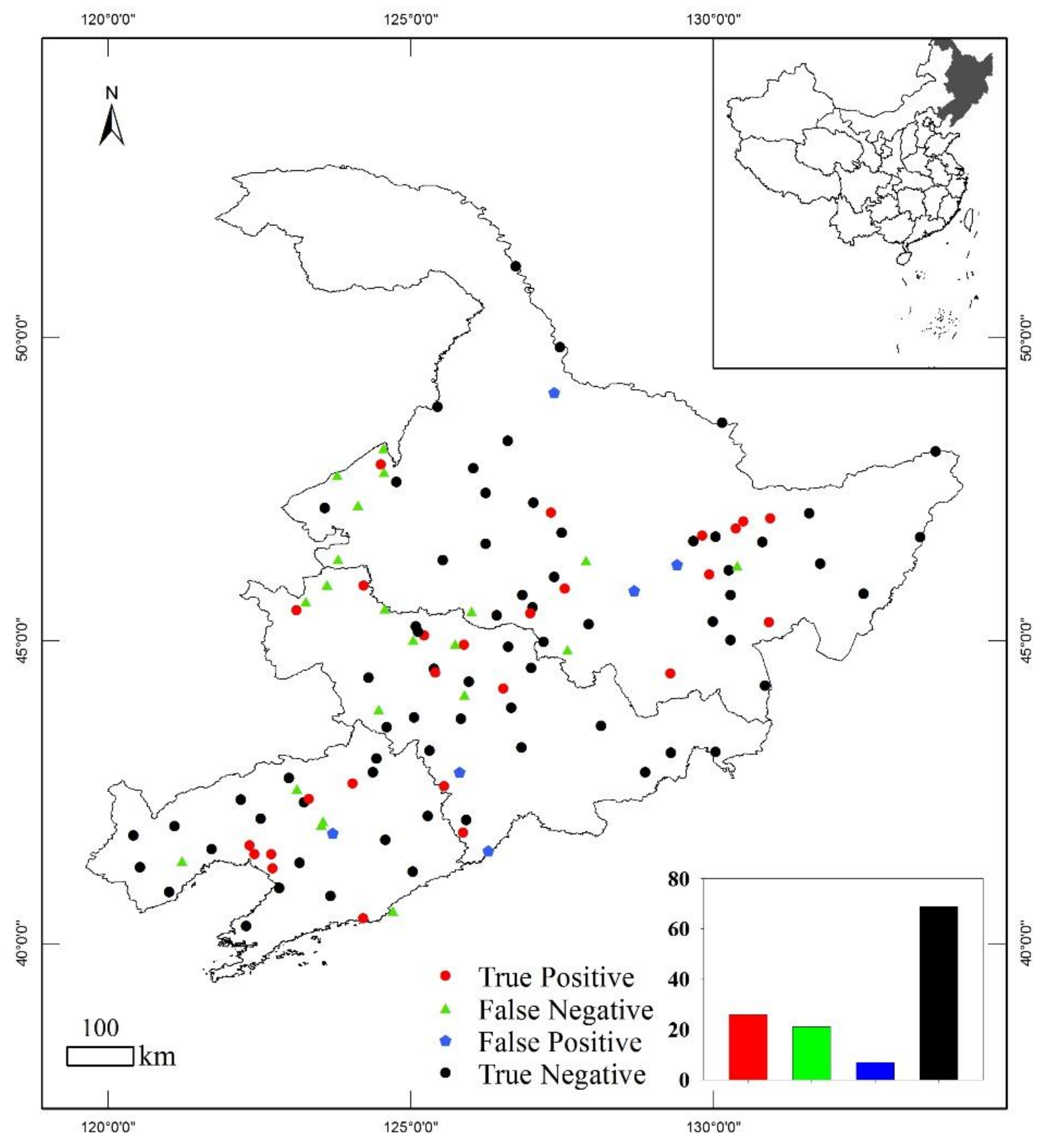
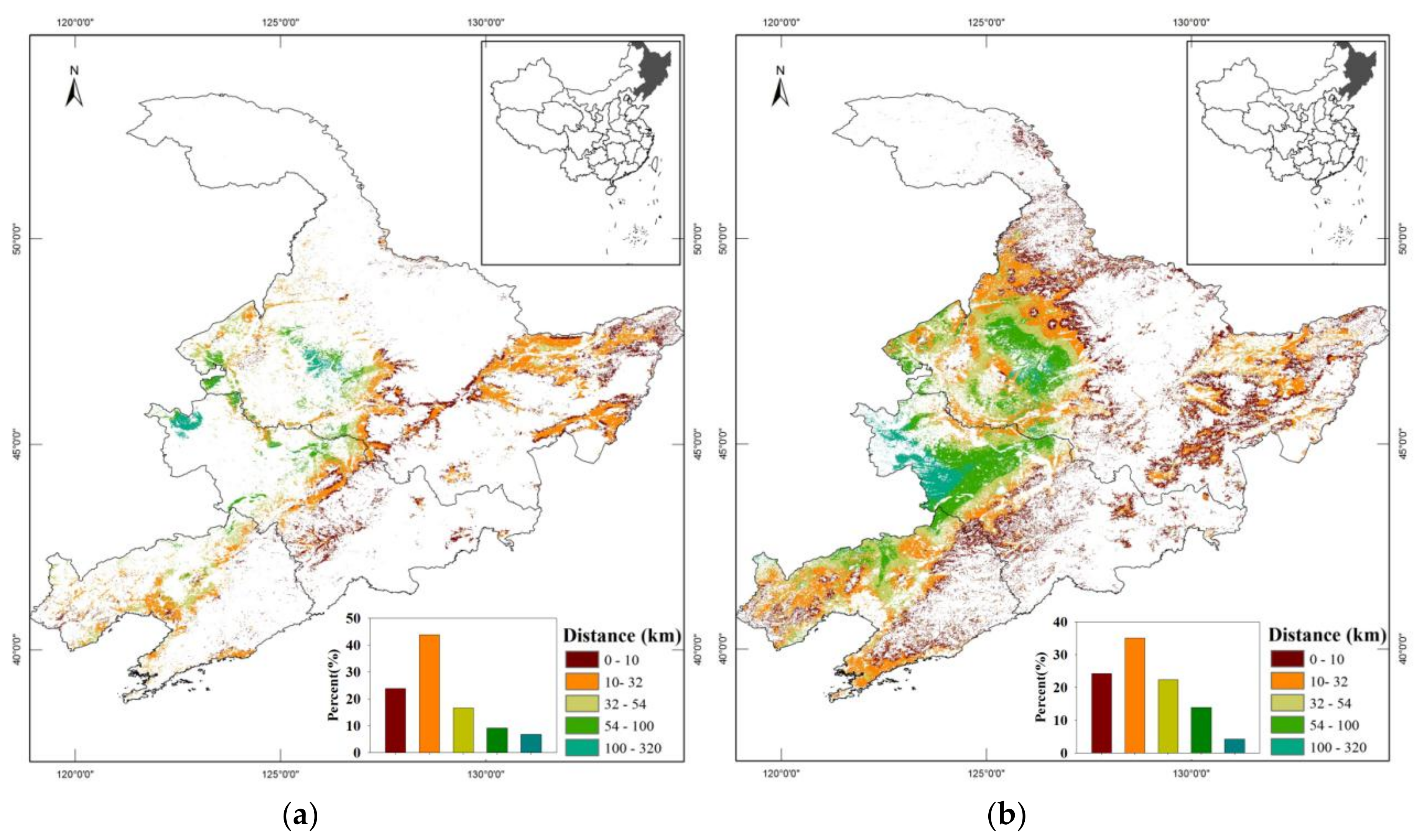
| Province | Statistical Areas (km2) | Estimated Areas (km2) | RPE |
|---|---|---|---|
| Heilongjiang | 53,052.00 | 39,038.56 | −26.41% |
| Jilin | 16,248.40 | 20,527.79 | 26.34% |
| Liaoning | 14,739.70 | 15,344.41 | 4.10% |
| Total | 84,040.10 | 74,910.76 | −10.86% |
| Class | Ground Observed Samples | Total | User Accuracy | ||
|---|---|---|---|---|---|
| Irrigation | Non-Irrigation | ||||
| This map | Irrigation | 26 | 7 | 33 | 78.79% |
| Non-irrigation | 21 | 69 | 90 | 76.67% | |
| Total | 47 | 76 | 123 | ||
| Producer accuracy | 55.32% | 90.79% | |||
| Overall accuracy | 77.24% | ||||
| Kappa coefficient | 0.49 | ||||
| Zhu datasets | Irrigation | 10 | 9 | 19 | 52.63% |
| Non-irrigation | 37 | 67 | 104 | 64.42% | |
| Total | 47 | 76 | 123 | ||
| Producer accuracy | 21.28% | 88.16% | |||
| Overall accuracy | 62.60% | ||||
| Kappa coefficient | 0.11 | ||||
| FAO/UF | Irrigation | 40 | 58 | 98 | 40.82% |
| Non-irrigation | 7 | 18 | 25 | 72.00% | |
| Total | 47 | 76 | 123 | ||
| Producer accuracy | 85.11% | 23.68% | |||
| Overall accuracy | 47.15% | ||||
| Kappa coefficient | 0.07 | ||||
| IWMI | Irrigation | 27 | 26 | 53 | 50.94% |
| Non-irrigation | 20 | 50 | 70 | 71.43% | |
| Total | 47 | 76 | 123 | ||
| Producer accuracy | 57.45% | 65.79% | |||
| Overall accuracy | 62.60% | ||||
| Kappa coefficient | 0.23 | ||||
© 2019 by the authors. Licensee MDPI, Basel, Switzerland. This article is an open access article distributed under the terms and conditions of the Creative Commons Attribution (CC BY) license (http://creativecommons.org/licenses/by/4.0/).
Share and Cite
Xiang, K.; Ma, M.; Liu, W.; Dong, J.; Zhu, X.; Yuan, W. Mapping Irrigated Areas of Northeast China in Comparison to Natural Vegetation. Remote Sens. 2019, 11, 825. https://doi.org/10.3390/rs11070825
Xiang K, Ma M, Liu W, Dong J, Zhu X, Yuan W. Mapping Irrigated Areas of Northeast China in Comparison to Natural Vegetation. Remote Sensing. 2019; 11(7):825. https://doi.org/10.3390/rs11070825
Chicago/Turabian StyleXiang, Kunlun, Minna Ma, Wei Liu, Jie Dong, Xiufang Zhu, and Wenping Yuan. 2019. "Mapping Irrigated Areas of Northeast China in Comparison to Natural Vegetation" Remote Sensing 11, no. 7: 825. https://doi.org/10.3390/rs11070825
APA StyleXiang, K., Ma, M., Liu, W., Dong, J., Zhu, X., & Yuan, W. (2019). Mapping Irrigated Areas of Northeast China in Comparison to Natural Vegetation. Remote Sensing, 11(7), 825. https://doi.org/10.3390/rs11070825





